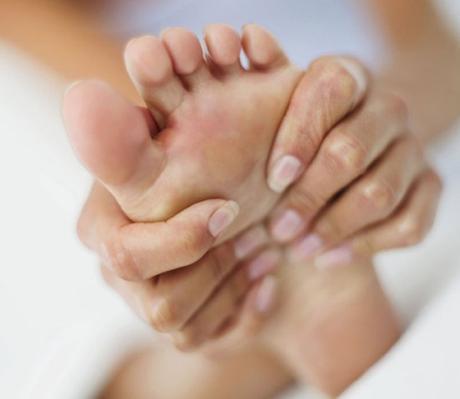

If you’ve ever had plantar fasciitis, then you know what a pain in the… foot it is! And if you haven’t, here are some great tips from our friends at PopSugar on how to avoid it completely!

From spending the week pounding the pavement in shoes that lack proper support, to spending the weekend pounding the hard courts, feet really take a beating!
If you’re always on your feet, whether at work or play, it pays to show your peds some love. Do some preventive prehab to avoid coming down with a case of plantar fasciitis.
This painful condition is an “overuse” injury affecting the fascia a thick, fibrous band of connective tissue that runs from your heel bone to the base of your toes. When the fascia is placed under too much stress, it stretches too far and tears. This causes inflammation of the fascia and the tissues surrounding it, painfully cramping your lifestyle with every step. Not only that, but the tears can become scarred as they heal, creating even less flexible tissue and making the problem worse.
Tennis players are especially susceptible to this condition because in a typical match, they spend about 1-1/2 to 2 hours, running forward and back, and from side to side, gradually tightening the calf muscles. The problem there is that as the calf muscle tightens, it pulls on the fascia at the heel, increasing its tension while decreasing its flexibility, and eventually causing tearing.
Yep, this is just one more important reason to stretch. Over training can lead to this condition too, and that is why rest days are vital.
The condition is more common in women, people who are overweight, and folks with wither flat feet or high arches. Also, over pronation (placing too much weight on the inside of the foot) can lead to plantar fasciitis when combined with worn out, unsupportive sneakers.
The major symptom of this condition is pain at the base of your heel, especially during your first few footsteps in the morning, or when you get up and start walking after sitting for a while.
If you’ve ever (or never) experienced this type of heel pain, try these methods to keep pesky plantar fasciitis at bay:
Loose Calves
Tight calves, a common side affect of running, pull on the fascia, stiffening the tissue and leading to tears. Keeping your calves loose is the first step to taking care of your feet. After every run, or workout, be sure to stretch your calves with at least one of these stretches:
Wall Calf Stretch
This is a classic calf stretch that you can do just about anywhere.
- Stand a little less than arm’s distance from the wall.
- Step your left leg forward and your right leg back, keeping your feet parallel.
- Bend your left knee and press through your right heel.
- Hold for 20 to 30 seconds and switch legs.
 Image Source: PopSugar
Image Source: PopSugar

Wall or Curb Stretch
This is one of the easiest stretches to do as soon as you finish a run. If you have weak Achilles tendons, do the variation using a wall instead of a ledge.
- Find a wall and stand a few inches away. With one foot, put your toes on the wall, keeping your heel on the floor, and flex.
- Hold for about 10-15 seconds, then alternate with your other foot.
- You can also do this stretch using a curb or step and hanging your heels off the ledge.

Flexible Feet
Aside from stretching the calves, keeping your feet flexible will help, too. Simply stretching the sole of your foot by pulling your toes back will help to lengthen the fascia. Here are the deets on this stretch – try it next time you’re plopped on the couch watching TV:
- Sit down on a chair or bench. Bend your left leg and place your left ankle on your right knee.
- Hold onto your left toes with your left hand and gently press your left toes to the right, so your foot is in a pointing position. Stay here for a few seconds.

- Then use your hand to pull your left toes to the left, flexing your foot.
- Repeat this stretch 10 times and then do it with the other foot. Complete this stretch at least three times a day to experience the full benefits.

Sole Massage
Another way to keep the foot fascia pliable is to massage your feet regularly. A tennis ball is a cheap, simple solution for daily foot massages, but but the smaller Rubz ball allows you to go a little deeper. If you’re experiencing foot pain, massage the sole of your foot with a frozen water bottle. The ice helps relieve any swelling that might have occurred.

Toe Workout
When was the last time you did strength training for your feet? Keeping the arches strong helps prevent plantar fasciitis. Daily toe scrunching exercises have helped keep many a player on the courts. Sit in a chair with feet planted on a hand towel over a hard surface. Scrunch toes in and hold for 5 seconds. Releax and repeat 10x, perform 3 sets per day.


